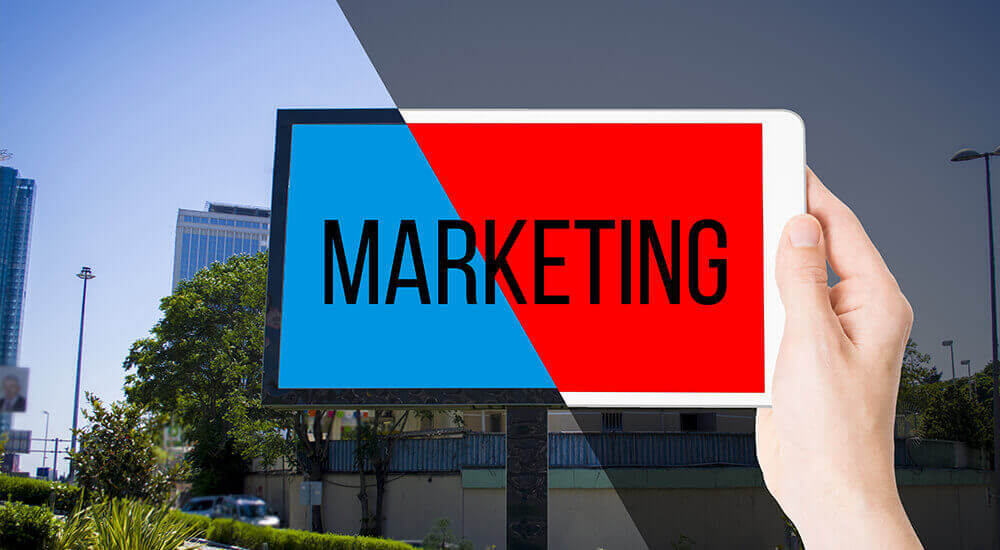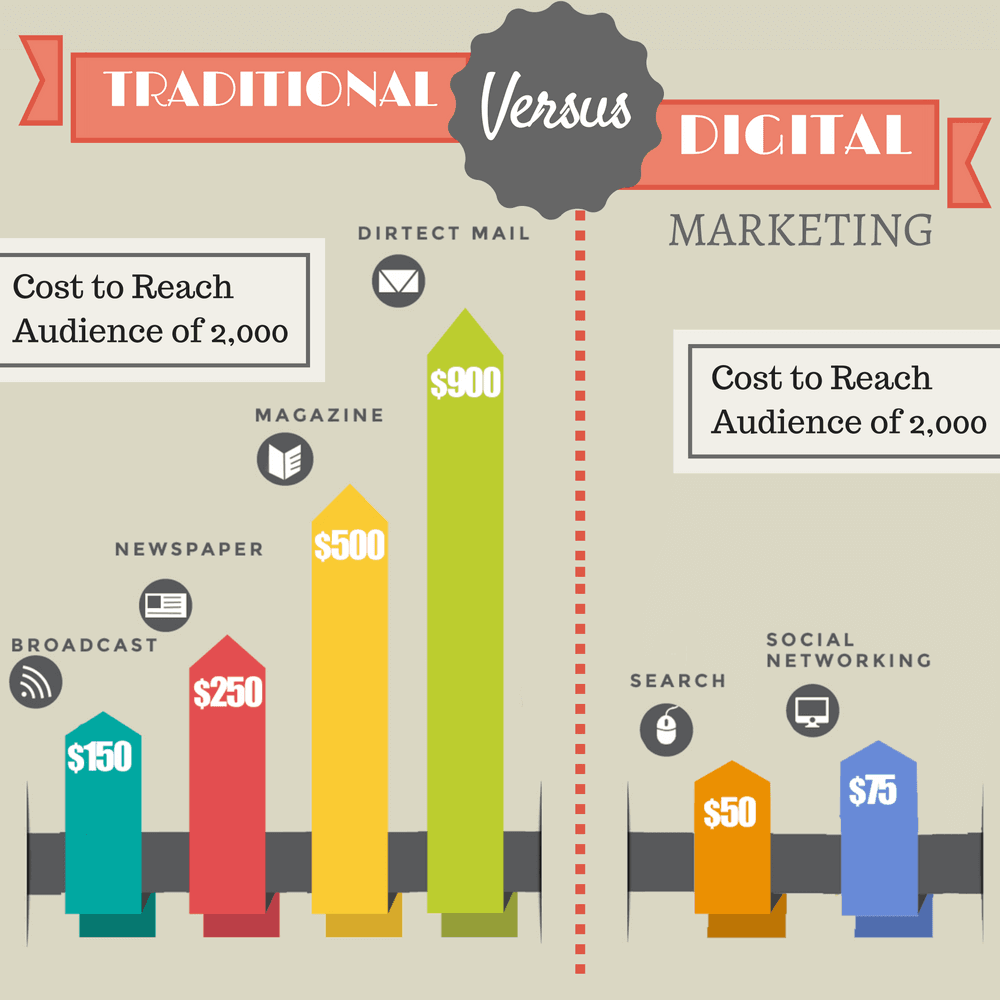Let's Talk
We would love to hear from you. Want to know more about our services or have any questions? Say Hi!
Traditional vs. Digital Marketing (Updated)

In the wake of the digital era, there are multifarious marketing channels at the disposal of brands that act as a medium to convey the brand message and build brand engagement through its interactive features. However, does this mean that the traditional marketing is passé?
Our clients are often mystified when it comes to choosing the ideal communication channel for their brand.
They ask us – Which is better – Traditional marketing or Digital marketing? This is one question many clients have asked us till now and our answer is always the same- both of them are good in their own way. However, it is essential to understand the difference between the two before going any further.
Get a glimpse of what you will discover in this blog:
- What is Traditional Marketing?
- What is Digital Marketing?
- If you want to reach a Wider Audience, traditional marketing is still relevant
- If you want to reach the Target Audience, digital marketing works better
- Market Segmentation- Traditional Marketing v/s Internet Marketing
- Availability and Accessibility- Online marketing and Traditional marketing
- Top-down and Bottom-up Approach of Marketing
- How McDonald’s turned its strategy from top-down to bottom-up?
- Neuroscience Supports ‘Traditional Media’
- Businesses in India are Embracing the Digital Revolution
- Which Medium Will Suit Your Business- Traditional or Digital?
What is Traditional Marketing?
The conventional method of marketing in the advertising space with one-way communication and a larger reach which comprise of print ads, hoardings, magazines, billboards, newsletters, promotional brochures, flyers, radio ads, television ads, etc. is called traditional marketing.
What is Digital Marketing?
The constantly evolving new media landscape that consists of all the digital technologies to bring a more personalized experience and reach the right audience by means of social media, SEO, blogging, content marketing, lead management, paid search, etc. forms the digital marketing.
If you want to reach a Wider Audience, traditional marketing is still relevant:
Many opine that traditional marketing is dead with the onslaught of digital marketing channels. However, the reality is something different.
Though digital marketing has caught the fancy of people, messages publicized through traditional mediums have a better recall value and has large acceptance from people.
Traditional marketing channels have been present for decades, hence, older generations find the message communicated through these channels more credible than any other mediums.
However, traditional marketing also has an authoritarian nature. Be it any channel, the message is broadcasted from just the advertiser’s perspective i.e. the one-sided view. The advertisers couldn’t immediately come to know its products or services impact in the market as these channels do not bring instant reactions from the audience. The advertisers must Sit, Wait and Hope for the positive results.
If you want to reach the Target Audience, digital marketing works better:
The technological convergence has helped the brands communicate in an appealing manner and has revolutionized the way consumers consume information.
Marketers now build a meaningful relationship with their consumers and request the audience to participate in the brand building process.
As technology has opened the gates to the worldly exposure, brands now sitting at one location can make a global impact and spread their philosophy far and wide.
Due to the availability of different channels, advertisers often cross-promote the brands that help them to connect with their target audience at different points.
Also, when the organizations promote themselves on social media channels, they can delve deeper into their strength and weaknesses as the choices of their audience can be easily known through their feedback in various formats.
Market Segmentation – Traditional Marketing v/s Internet Marketing
Due to the emergence of more interactive tools on social media, market segmentation has taken a completely different route. Earlier, the market segmentation when it was started in the 1950s, it was purely done based on geography, age, gender, profession, and income.
With the changing times and attitudes of people, ‘Socialgraphics’ are now used that helps to track people with common interests, opinions, and behaviors. This is called psychographic segmentation where with the help of various monitoring tools the brands can gain insight on the emotions that user displays towards their product or service.
Hence, social media facilitates market segmentation in a broader way compared to the traditional media.
Availability and Accessibility – Online marketing and Traditional marketing
In the case of traditional marketing, it completely depends on the brand when and where they wish to advertise their message. Here, the advertiser has the power to control how much and what sort of information should be made available to the audience.
Digital marketing can be easily accessed at any time of the day. Consumers can access any information they seek at any time or any place.
When on social media, brands are not confined to the limitations of place and time. Also, updating the message or establishing cordial relationships with the consumers can be easily done on social media.
We understand, even after weighing & discussing the differences between traditional marketing and digital marketing, it can be mind-boggling for the marketers to choose between the two.
In this case, try to think from an angle of Top-down and Bottom-up marketing approach.
Top-down and Bottom-up Approach of Marketing
While considering which marketing channel will work best for your business entity, you should also conduct a deep study of the top-down and bottom-up marketing approaches for more clarity and certainty.
The traditional media often employs the top-down model of advertising which is preachy, wherein the major player is the advertiser who constructs a strong message to influence the consumer’s mind.
Contrary to this, the bottom-up approach is an all-inclusive approach that studies the target audience and strategizes smartly to meet the expectations of people in a creative way.
Owing to its farsighted vision, the bottom-up approach helps the business to focus on their long-term goals. This kind of approach mainly uses digital marketing channels where the consumer plays an active role in disseminating and promoting the brand philosophy and the message.
Let us understand these approaches in detail by studying the marketing strategies adopted by the American fast-food giants in India, namely McDonalds:
How McDonald’s turned its strategy from top-down to bottom-up?
McDonald’s for many years followed the top-down marketing approach.
Making use of traditional marketing channels, it marketed its McAlooTikki Burger as the low-priced yet stomach filling food readily available at their outlets.
Also, it re-engineered its menu as per the Indian preference and came up with chicken, fish and lamb burgers replacing its beef or pork burgers popular in other countries.
However, in the year 2012-13, the company felt the urge to re-invent its marketing model owing to the more international fast-food rivals like KFC and Domino’s spreading its wings in the market and their attempt to engage the audience at various digital touch points.
McDonald’s soon adopted a bottom-up strategy by capitalizing on the mushrooming café culture in India.
It launched the campaign “McCafé for every moment,” not just on traditional television channel but also on various digital channels to engage with the audience across multiple devices and channels. The new film talked projected McCafé as a place for every little celebration like meeting a long-lost friend, dealing with a break-up, need a break from shopping and much more.
As per the research by McDonald’s, the youngsters were looking for options, other than lunch and dinner timings, where they can sit for hours, chat, have good food and socialize.
Hence, the revamp of McDonald’s outlets as the McCafe was a thoughtful strategy implemented in the light of the rising competition and the changing habits of the millennial consumers.
McDonald’s also launched the McDelivery app to provide its customers hassle-free online delivery of their favorite burgers, hence adding more convenience and establishing a personal connection with the end consumer with the help of technology.
Neuroscience Supports ‘Traditional Media’
A study done by the Canada Post and performed by Canadian neuro-marketing firm TrueImpact compared the effects of paper marketing with digital marketing.
The study made use of two technologies- Eye-tracking and High-Resolution EEG brain wave measurement. The study analysed certain factors such as Cognitive load (ease of understanding), motivation (persuasiveness), attention (how long subjects looked at the content).
The results were indeed startling: Direct mail requires 21% less cognitive effort to process than the digital media. When asked to cite the brand (company name) of an advertisement they had just seen, the recall was 70% higher among participants who were exposed to a direct mail piece (75%) than a digital ad (44%).
Businesses in India are Embracing the Digital Revolution
As per one of the researches, in 2021, Indian internet traffic is estimated to be 291 times bigger than in 2005.
Many studies have indicated the Indian marketer’s inclination towards social media and Email marketing strategies as they deliver maximum ROI with low investment.
One of the studies indicated that 61% of customers trust e-commerce solution providers as they engage the audience with more personalized and interactive content.
Plus, with the increasing mobile users in India and their access to social media will open the doors of opportunities for marketers to promote their product in an appealing way and reach global audience by making best use of the digital technologies.
With such promising returns, digital marketing will gradually become an inevitable part of marketing strategy and will create boom in the coming years.

Image Source: Surgerealtysolutions.com
Which Medium Will Suit Your Business- Traditional or Digital?
Though digital media has taken away the brands by storm, this doesn’t mean that the traditional media has lost its sheen.
It has been observed that the brands who devised the marketing strategy after considering the media channels that their audience is exposed to and built the brand story accordingly have greater chances for success.
If traditional media has the power to impact deeply, then social media is equipped with communication tools that converse with consumers in an appealing tone. Often the consumers search for a brand online that they have seen the hoarding to validate the authenticity.
Hence, brands that devise digital marketing strategies in conjunction with traditional approaches make a big impact in the market and rise to success swiftly.
If you have more views to share regarding the optimal use of traditional and digital marketing channels, we are all ears.


